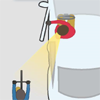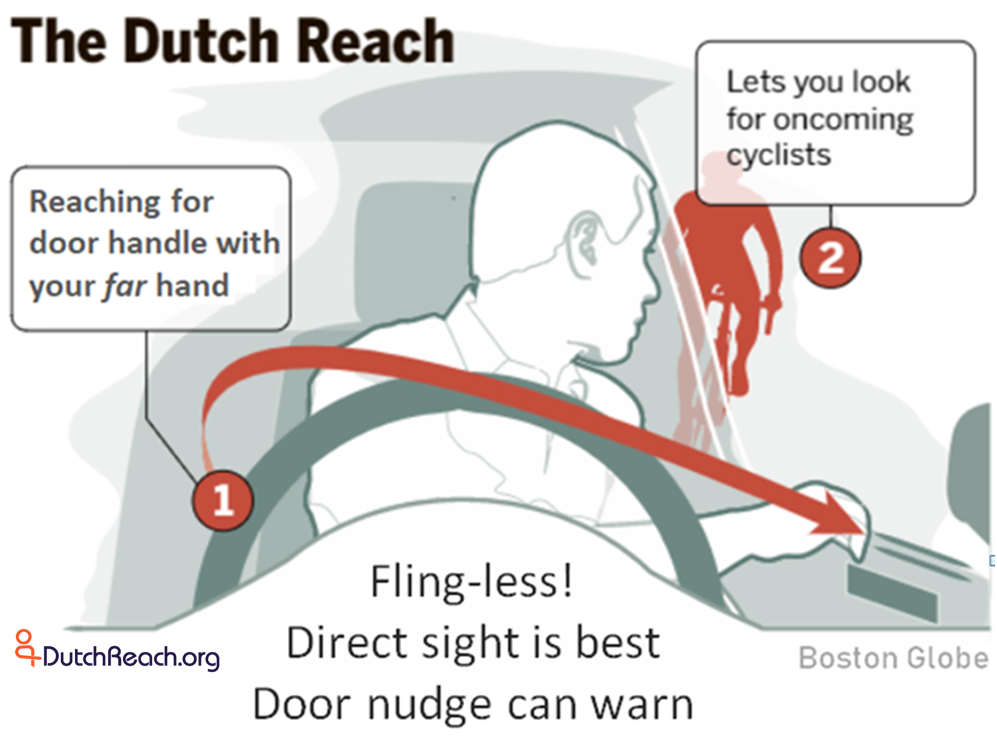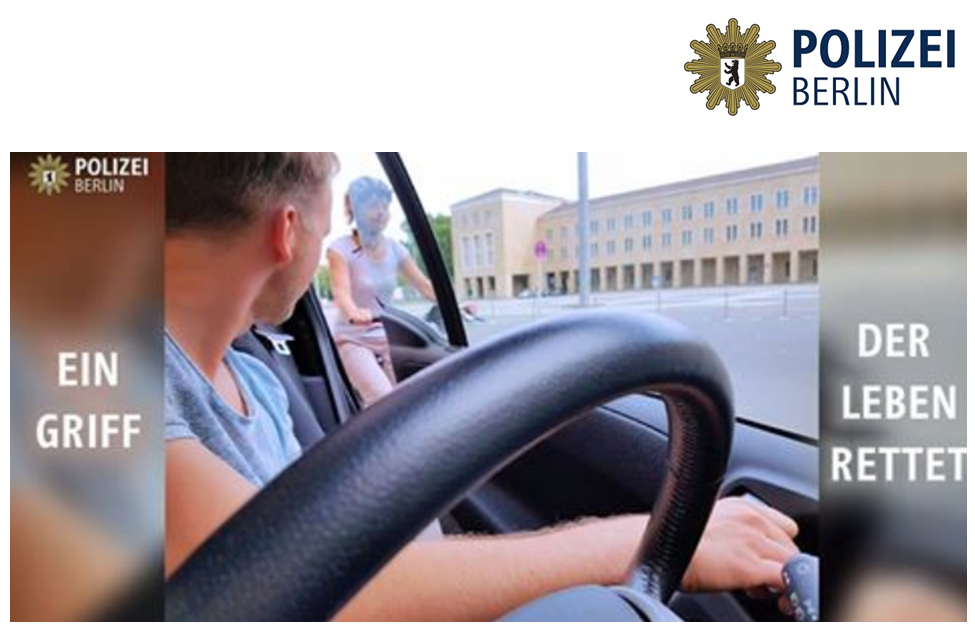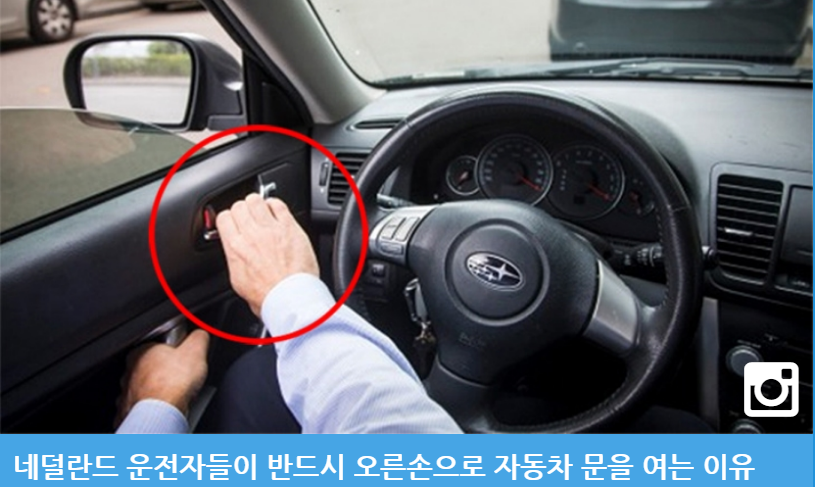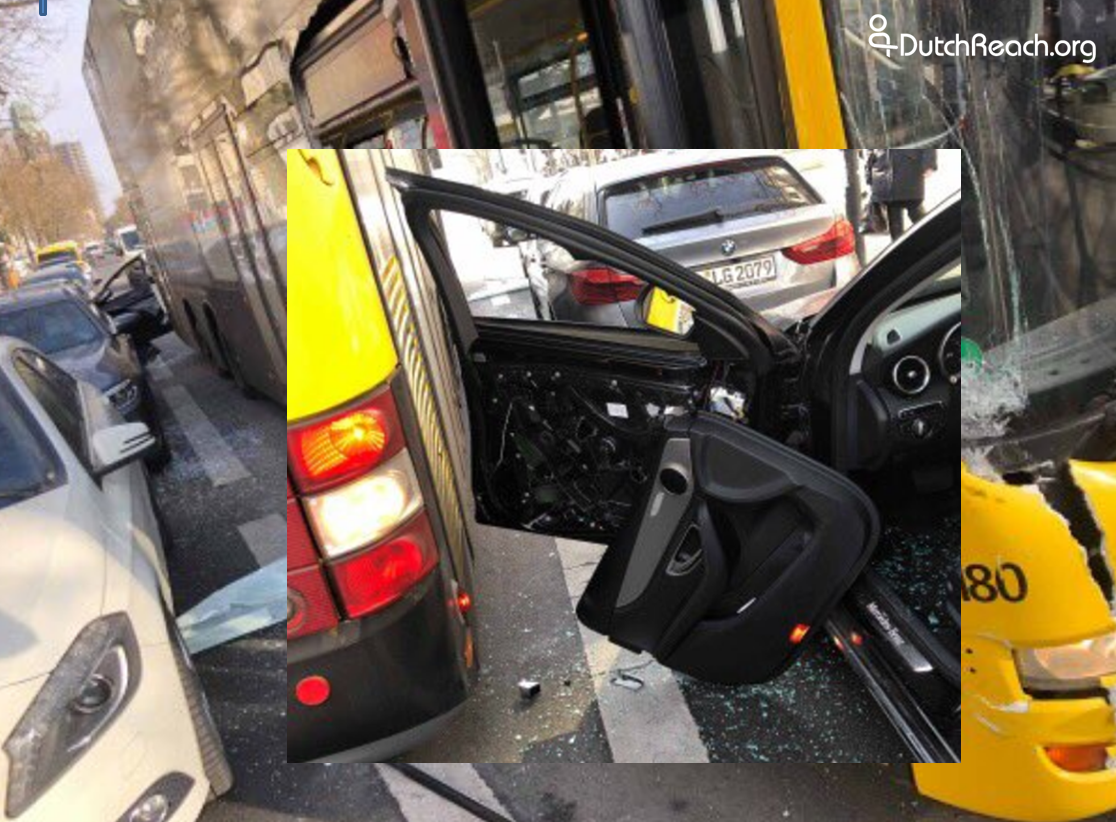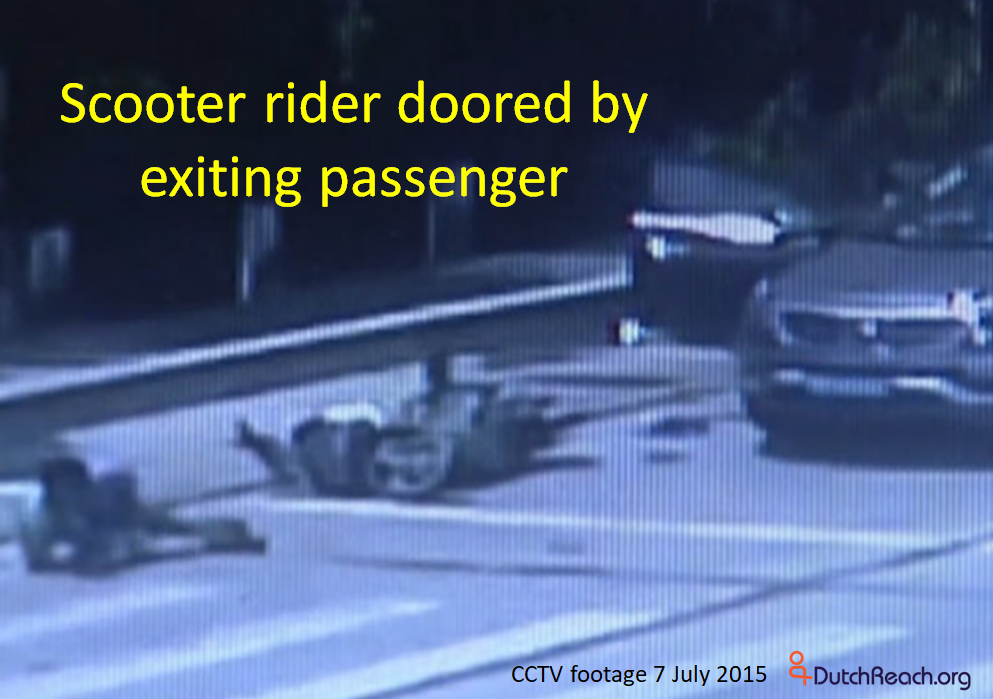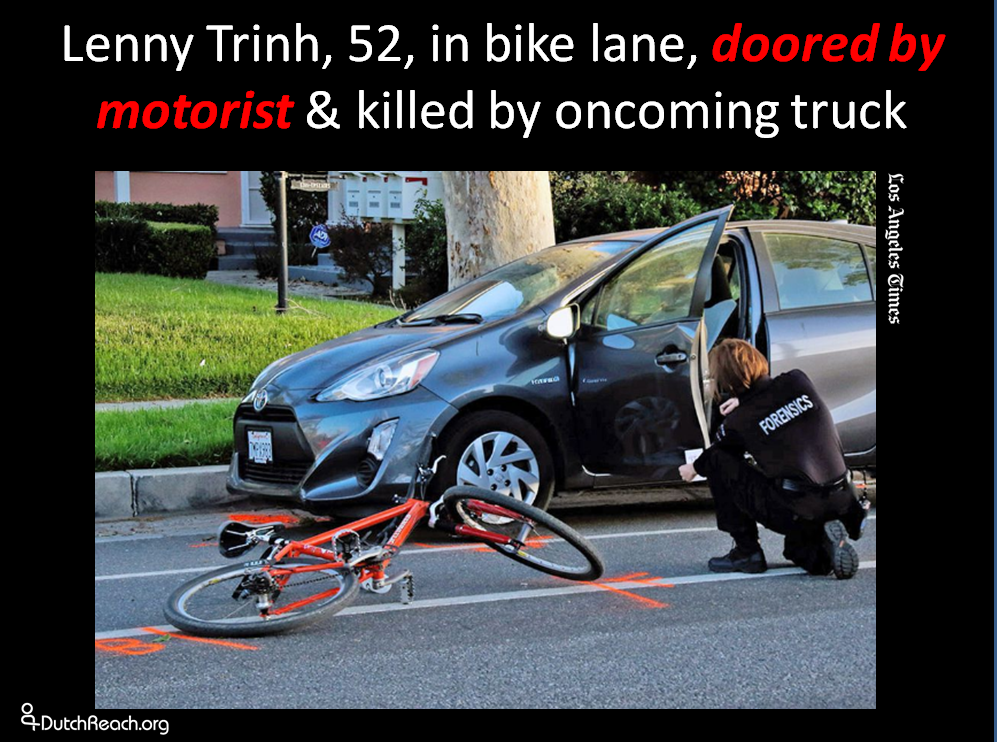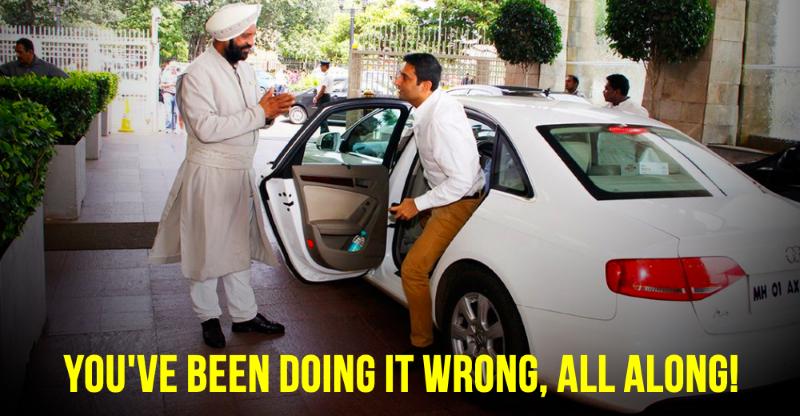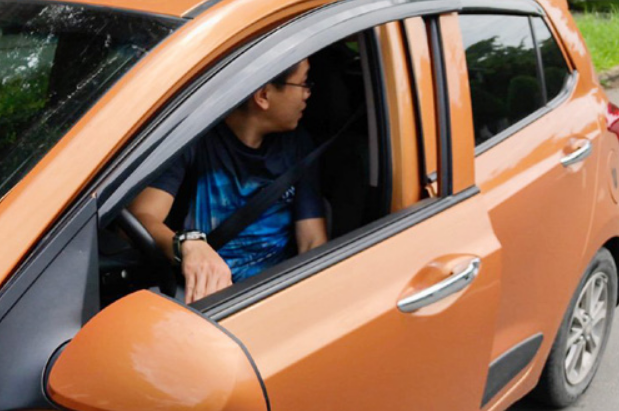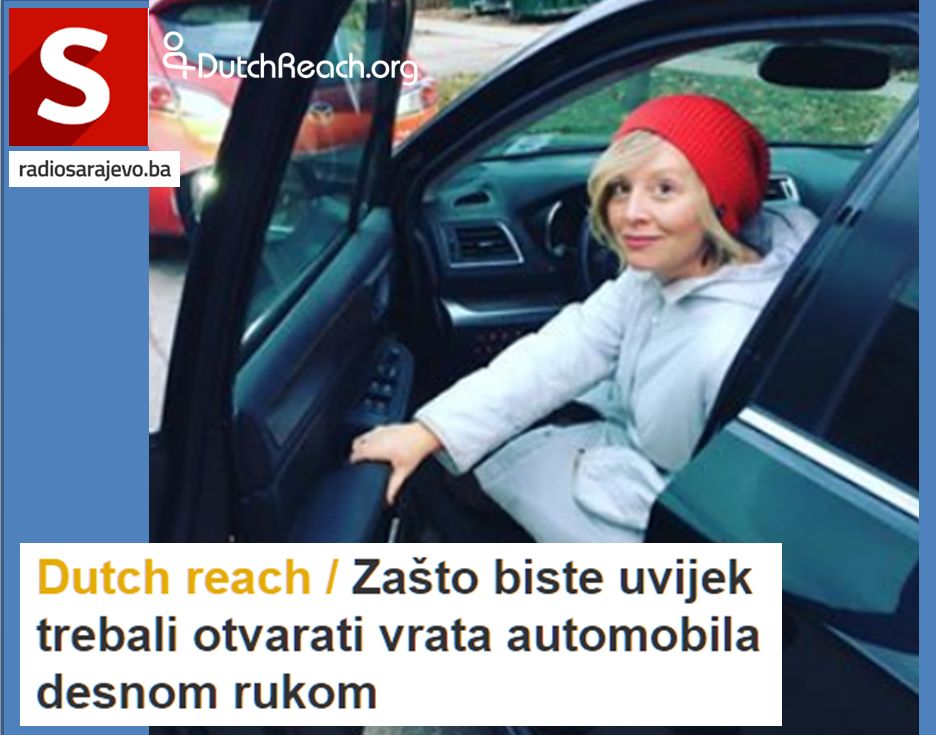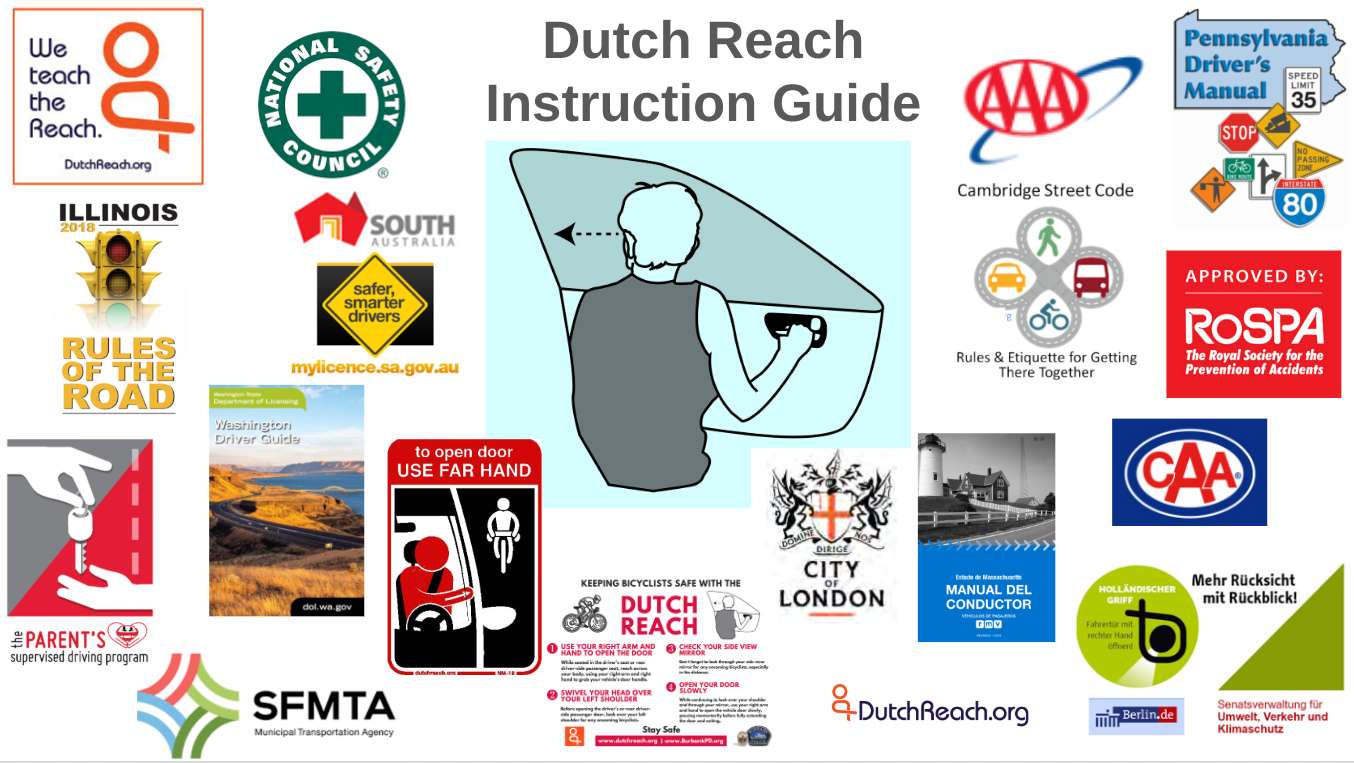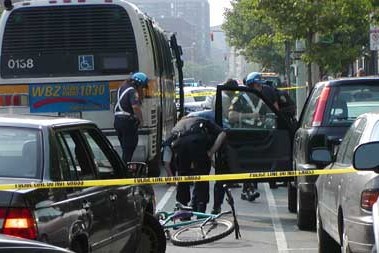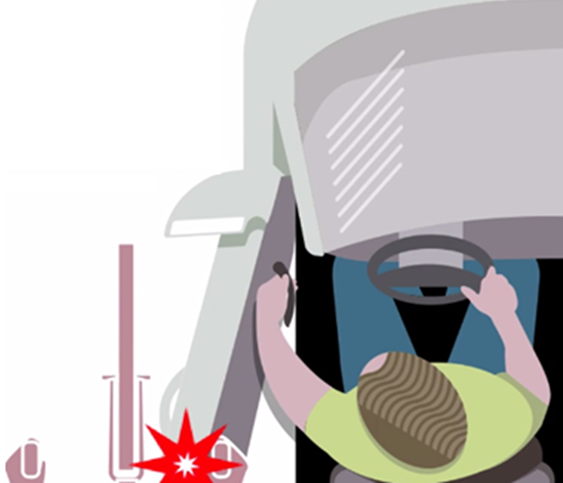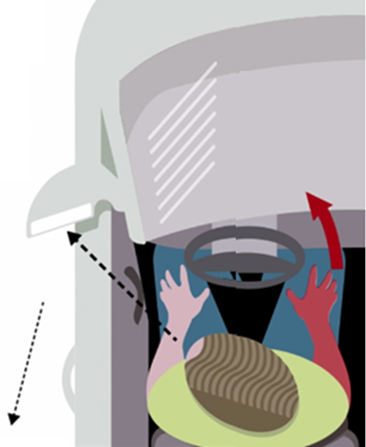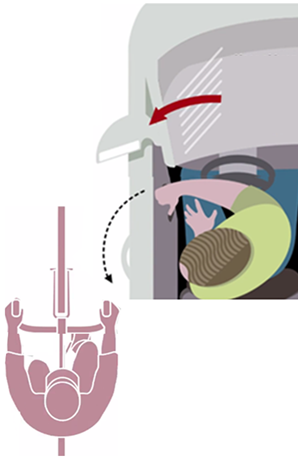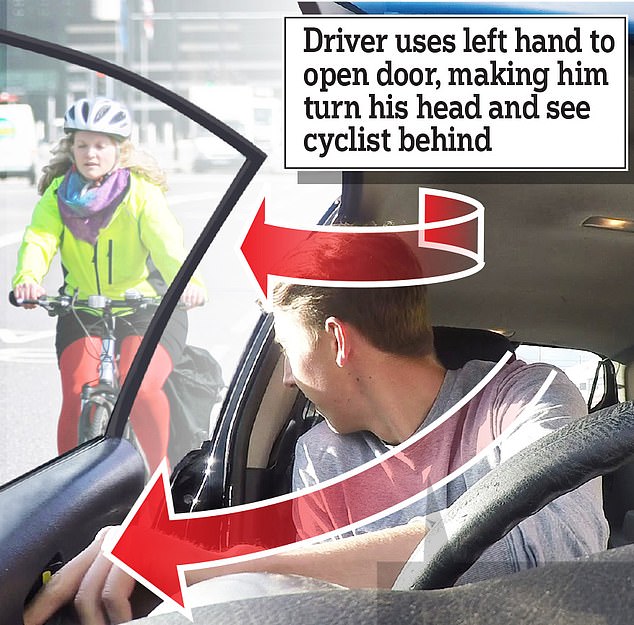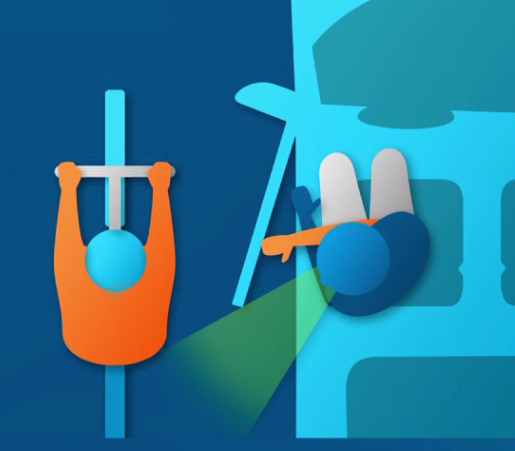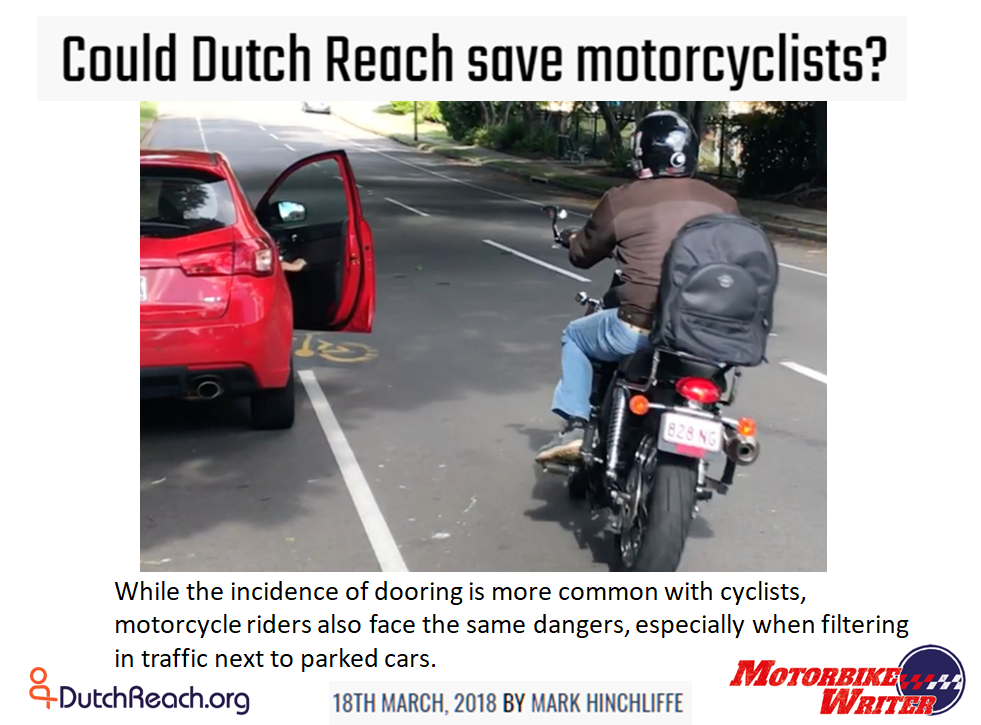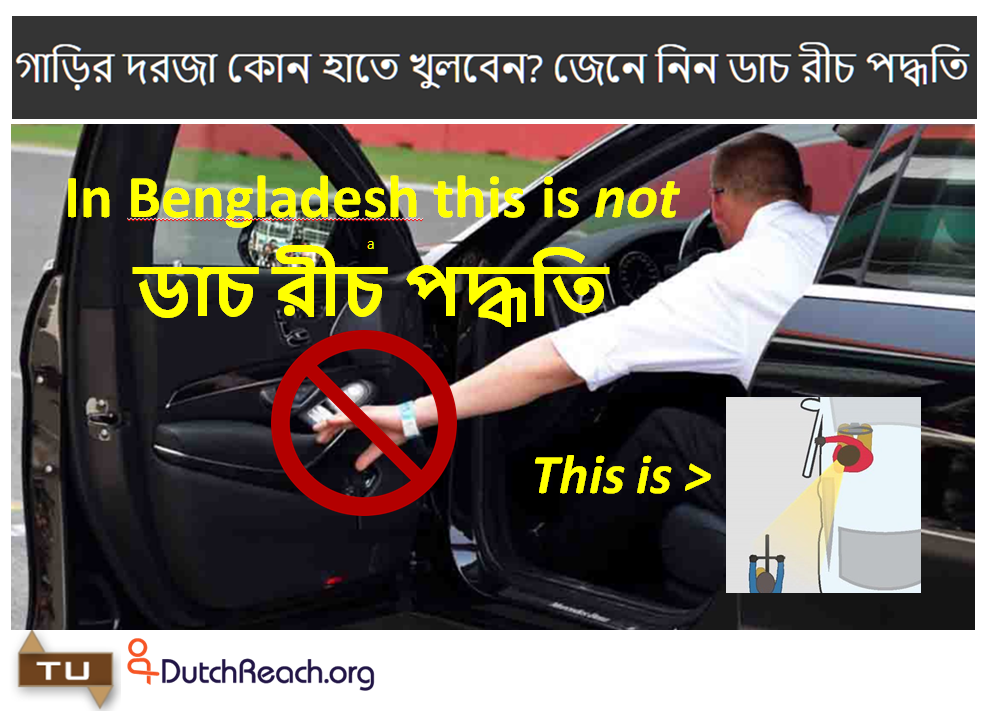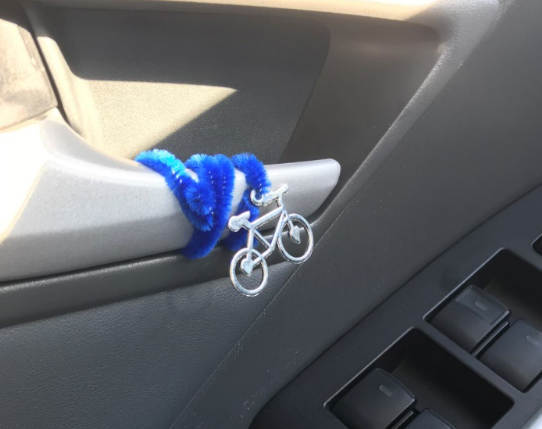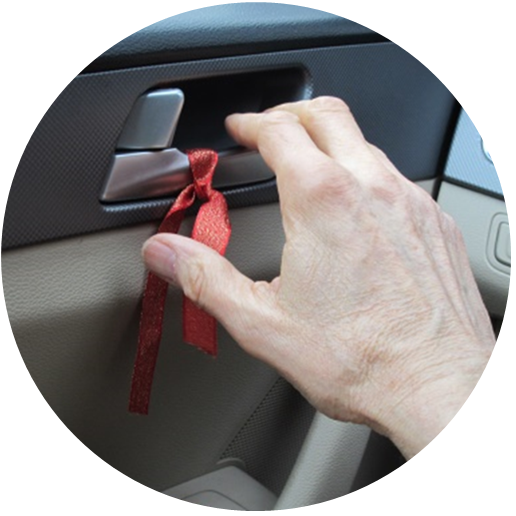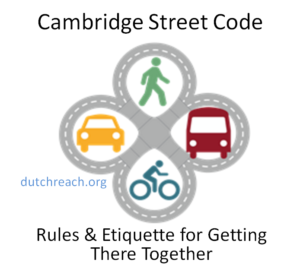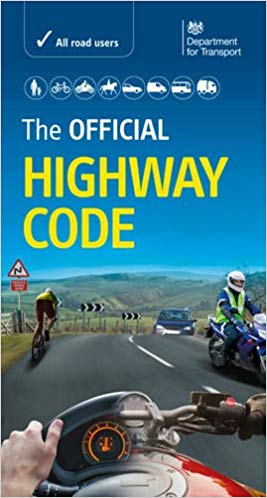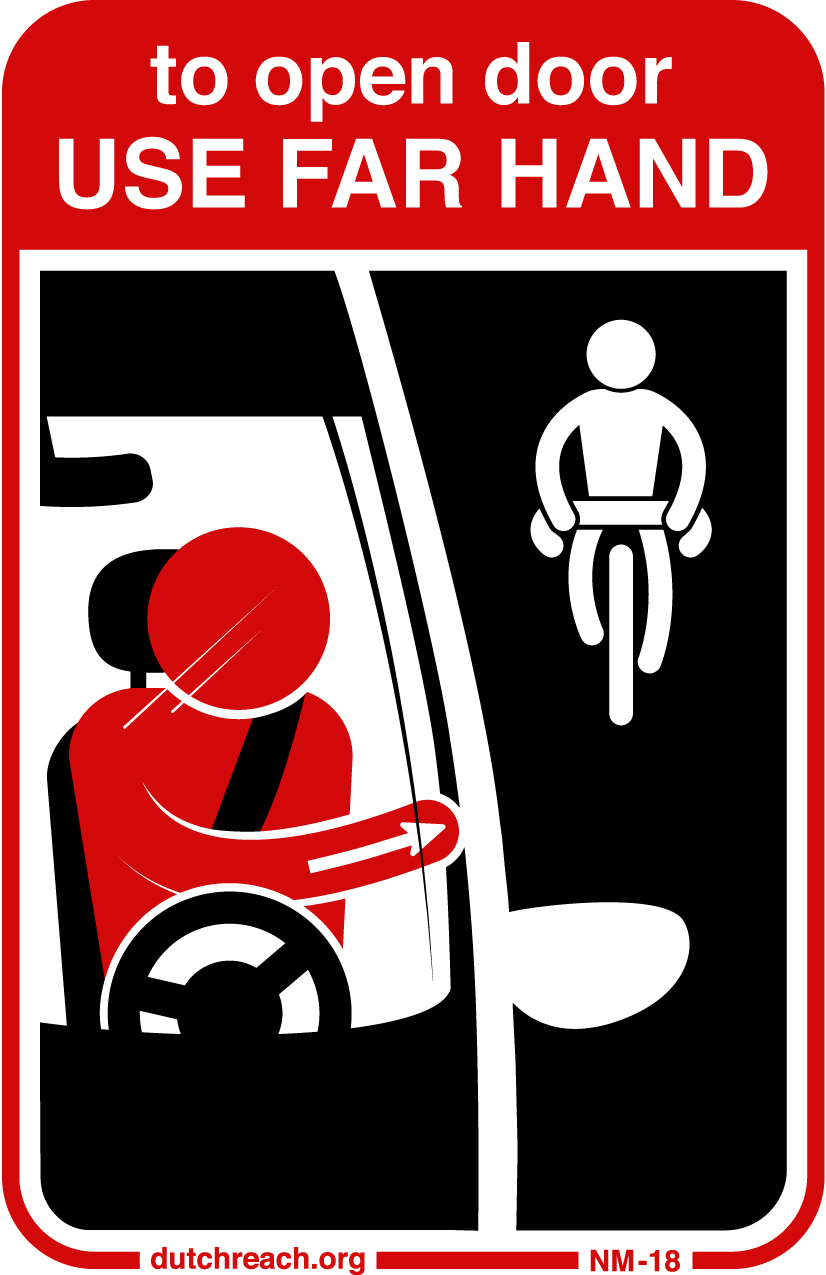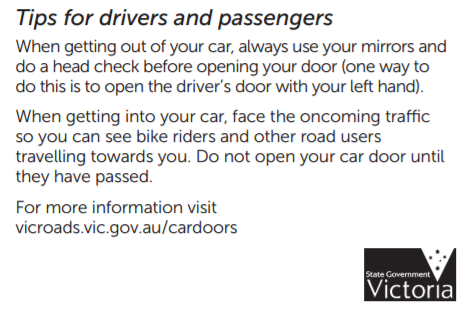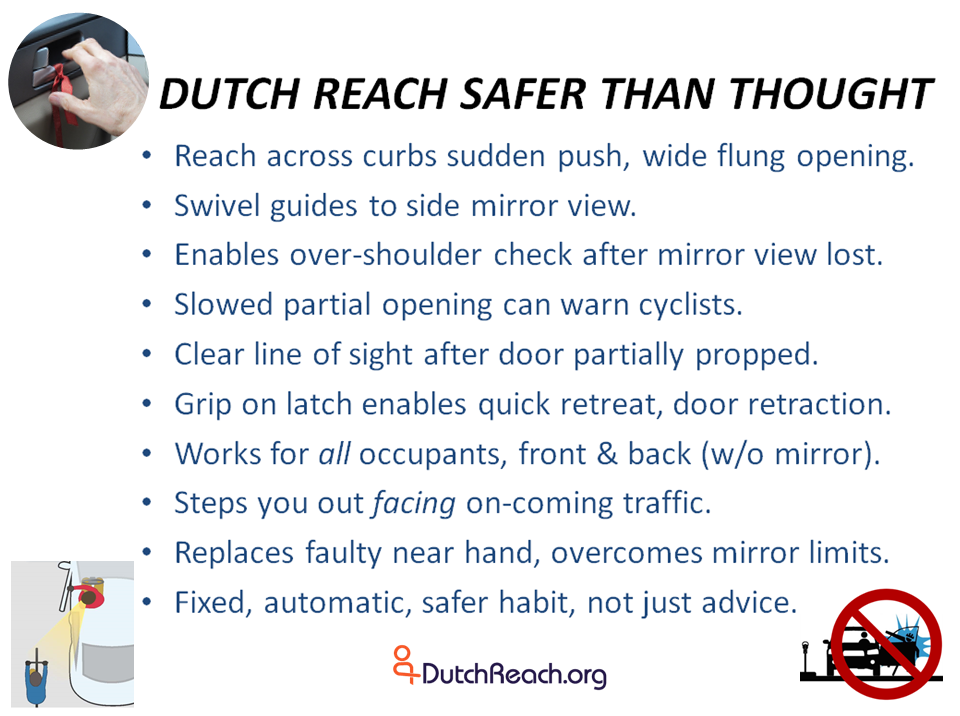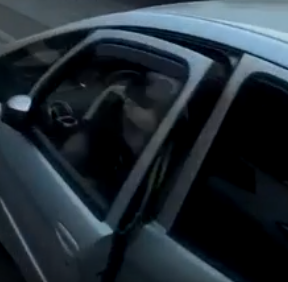A Guide & Gallery for Road Safety Officials, Experts & Advocates
This introduction details the Dutch Reach far-hand habit for safest exiting of vehicles. Comparison is made to the near-hand habit which it should replace for reasons soon to be made clear. Below the Guide you can see how this countermeasure is instructed by other governments, road safety experts and advocates.
'Dutch Reach' instructions range from a few words - Open with far hand - to multiple steps. No one phrase, text or set of steps fits all. But the examples below may help you craft your own version. Other wording, graphics & videos can be found elsewhere on this site, including accounts in 32 languages & versions for left-side of road nations.
Feel free to browse the Gallery below first. But come back up for the talk!..:
A GUIDED TOUR OF 'DUTCH REACH'
The Dutch Reach can be taught in one short phrase. However truly safe exiting requires multiple steps before, during & after its signature move.
Wonderfully, the far-hand habit automatically prompts - even compels - all succeeding steps. And each new step adds more safety, as will be explained.
While you work to craft concise instructions, it's worth keeping in mind the hidden steps and rationales. This knowledge may shape your final wording. It may also help you draft curricula or prepare briefings, press releases, behavior change campaigns, advocacy letters, etc.
So please consider this detailed set of 'Dutch Reach' instructions:
- Turn off ignition, set brake, release seat belt.
- Check both outside and inside rear-view mirrors for vehicles & cyclists in back and in adjacent bike or travel lanes.
- Using hand further from door, Reach across to door latch. [Note: This forces upper body & head to turn outward; the near hand habit does not cause rotation.]
- Mid-swivel, (again) Check side/wing mirror. [Note: Near hand habit does not induce side-mirror use.]
- Twist further, look out the side & back over outer shoulder for oncoming road users. [Note: Near hand habit again encourages neither. In fact using near hand on latch cripples shoulder-check as it freezes the outer shoulder. This blocks torso rotation. One's turned head & eyes cannot twist further to get the view directly back.
- Still vigilant for oncoming traffic, Unlatch door but keep hand grasped upon handle.
- If safe, with near hand now assisting, Open door a few inches & lean slightly out to gain a clear, unobstructed view back for approaching traffic.
[Note: On this point multiple advantages result --
a) Reaching across ones body to operate the latch and open the door automatically curbs sudden, wide or flung opening. This habituated safety gain over the near hand push or thrust habit is immense -- and vastly under-appreciated: Few people can push or shove a door wide open using the far arm. And no one can if their far-hand latch grip is kept hold. But a near-hand push or shove allows and even encourages door throwing.
b) Fast, flung, ambush opening startles or completely blindsides cyclists. Too often it results in grave harm. A handlebar nick can crash the bicyclist and throw them into the roadway. A direct hard impact of bike or body, or desperate swerving with loss of control, cause violent crashes, against or even over the door wall. Even without loss of control a quick swerve to avoid direct dooring puts the cyclist in path of vehicles and can prove fatal.
c) Far hand on door latch and near hand on arm rest retain one's ability to retract door quickly, or prevent a gust blowing it open - which can also damage the door.
d) Window, door frame & 'B' pillar no longer limit exiter's view back.
e) The side mirror alone cannot provide full safety. In addition to misadjustment, blindspots, glare, darkness, compromising dirt or water, etc., once a motorist shifts or turns their head or, if the side mirror is door-mounted and the door then opened, its view back is completely lost. Some side mirrors now include a small convex secondary mirror which, though distorting, may help. However the continuous, unobstructed direct view back encouraged and achievable by the Reach method provides the most assured view, and does so just when the decision to open for exit is to be made.
f) The Reach method is especially needed for rear passengers. For they lack all mirrors. Likewise, the inside rear view mirror serves only the driver - and is useless for front passengers.
g) Slow partial opening can warn cyclists & may allow time to yell and cause the operator to retract the door as their hands still control it. This nudge warning gives a cyclist chance to brake or more safely steer to avoid harm.
h) Slight initial opening also allows cyclists more safe space to manuever and reduce swerve risk.
8. All clear? Open slowly. Remain vigilant. Exit facing traffic, ready to retreat if needed. [Note: With far hand still on door latch, drivers & passengers naturally exit facing back. Near hand habit positions motorists to exit facing forward, their back to oncoming traffic. Also, with door still held during exit, occupants are less likely to release and open door to its widest extent - a practice which should be discouraged unless necessary.]
9. Still facing traffic, walk around back of vehicle to gain sidewalk. [Note: The Reach thus guides all vehicle occupants to exit more safely onto and then off the roadway.]
Taken altogether, the Dutch Reach method minimizes dooring risks and harms for cyclists & other vulnerable road users and their vehicles. It is also safer for drivers & passengers at no cost but for habit retraining. It avoids door damage, traffic violations, fines, license loss, insurance claims & point penalties, civil liability & criminal prosecutions, life disruptions & delays, work time or employment loss, shame and guilt. Society too is spared needless police, rescue, hospital long term medical costs, road blockage, municipal, court and other resource depletion.
As shown, the Dutch Reach increases the safety margin of drivers who already exercise some caution on exiting. It would greatly reduce the hazard of drivers (found by British survey at 35%) and passengers who habitually do not.
See also: Far Hand is Safer Than You Think!, The Habit of Safety & Practice Tips.
A Comment on Dooring
Most motorists & passengers are unaware of dooring risks or the coinages 'dooring,' 'car-dooring' or 'doored.' Fewer know 'Dutch Reach', or why our near hand 'commonsense' push habit is dangerously flawed. They also may not know the term 'Vulnerable Road User,' or that doorings involve not just bicyclists, but also motorcyclists, mopeds, scooters, joggers in-like skaters even pedestrians; also that trucks, buses, streetcars, vans, pickups or other cars can be 'doored,' or door them, taking doors & lives with them.
Gallery of Dutch Reach Instructions
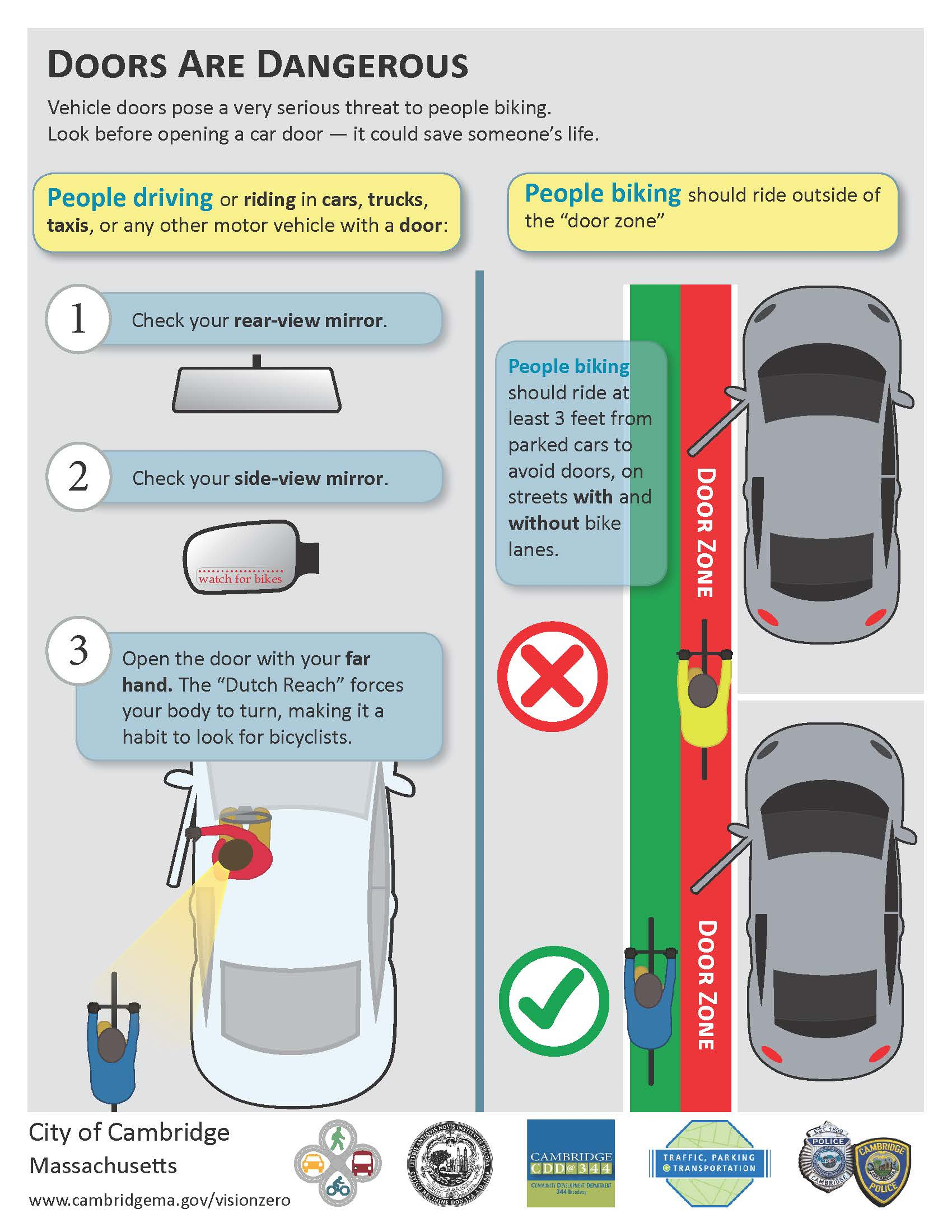
Doors Are Dangerous, p. 9, Cambridge Street Code: Rules and Etiquette for Getting There Together, Cambridge, MA, USA, (2016). Credit: City of Cambridge, image in public domain. Click image to enlarge.
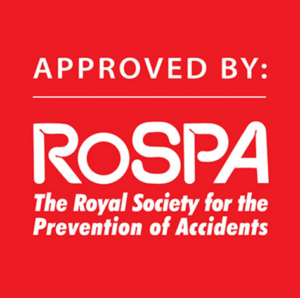
Dutch Reach approved by RoSPA February 1, 2017. See RoSPA's advisory here.
Dutch Reach Road Safety Advisory - Royal Society for the Prevention of Accidents (2017)
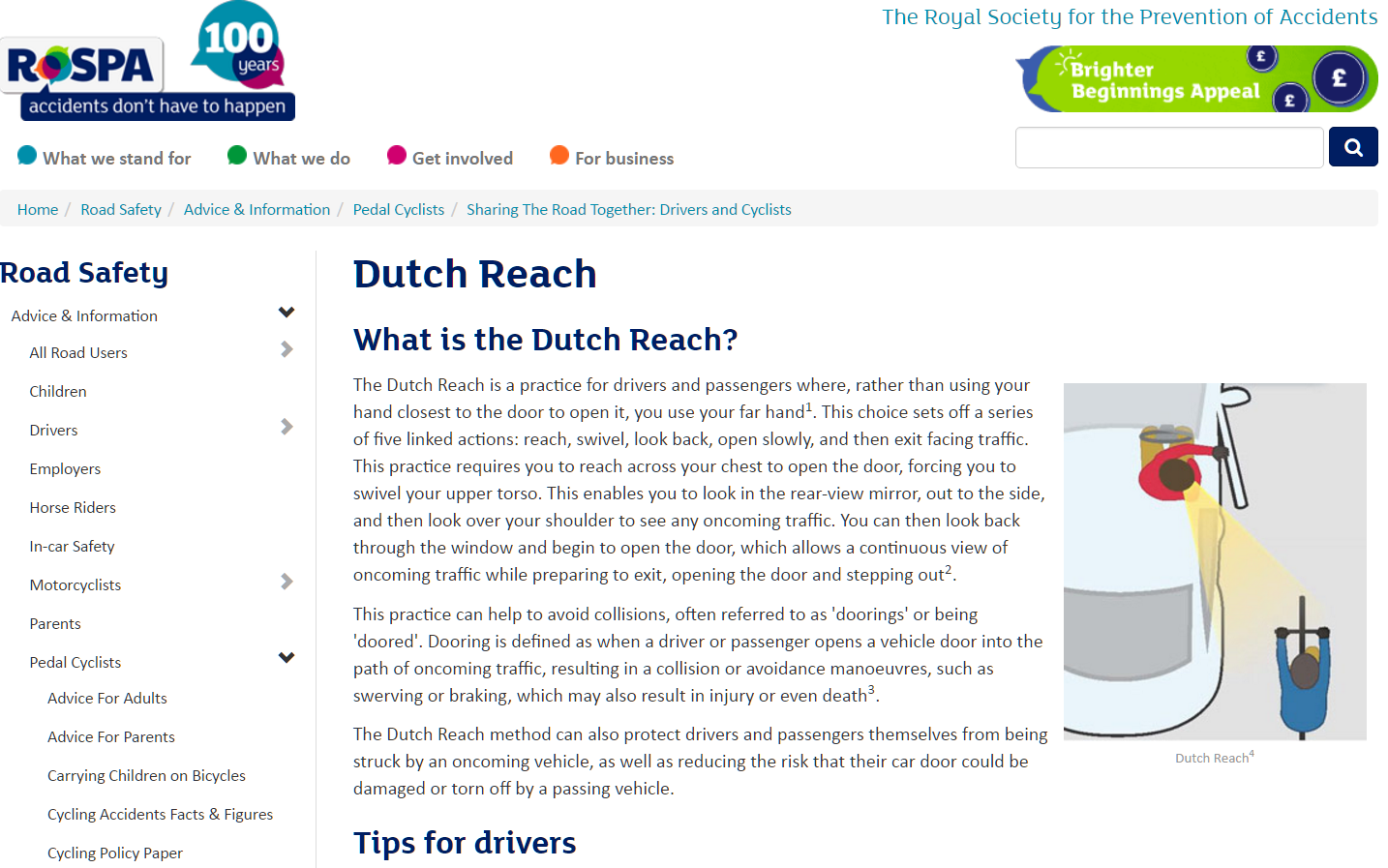
Dutch Reach Advisory, Royal Society for the Prevention of Accidents, UK, 2017. 1 of 2. Click to enlarge.
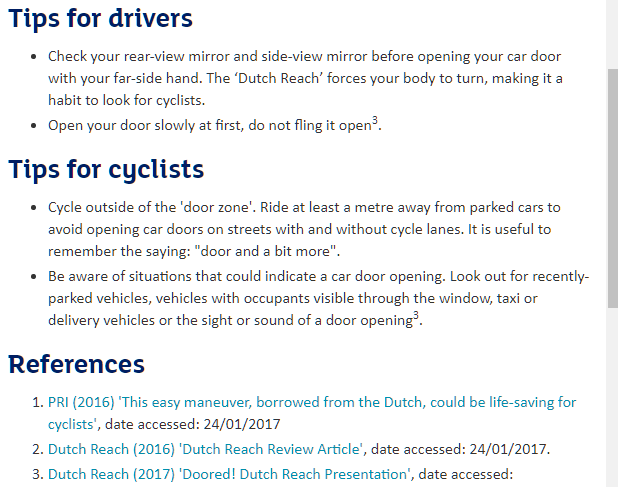
RoSPA Dutch Reach Advisory, continued: Tips for Drivers, Tips for Cyclists, & References. 2/2. Click to enlarge.
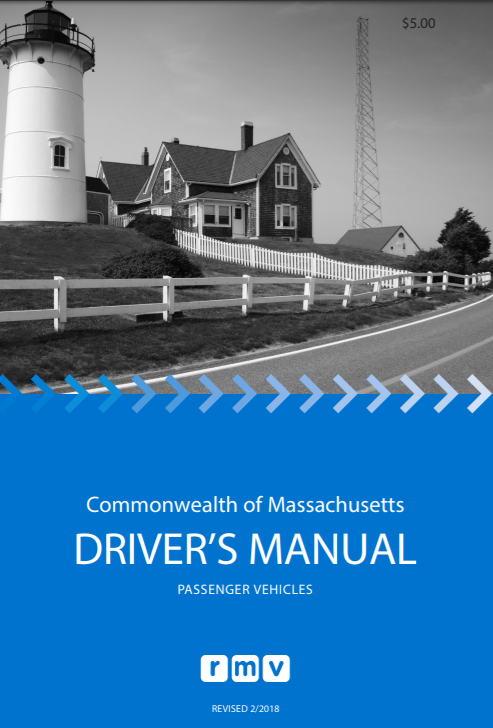
Massachusetts Driver's Manual, Click for pdf (2018). See p.111.
Dutch Reach - Massachusetts, USA, Driver's Manual (2018)
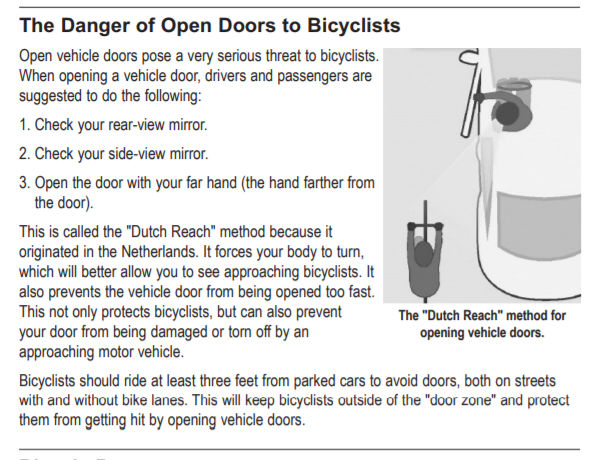
The Danger of Open Doors to Bicyclists,. p.111, Massachusetts Driver’s Manuals. Click image to enlarge. More on MA Manual, Press Release & coverage.
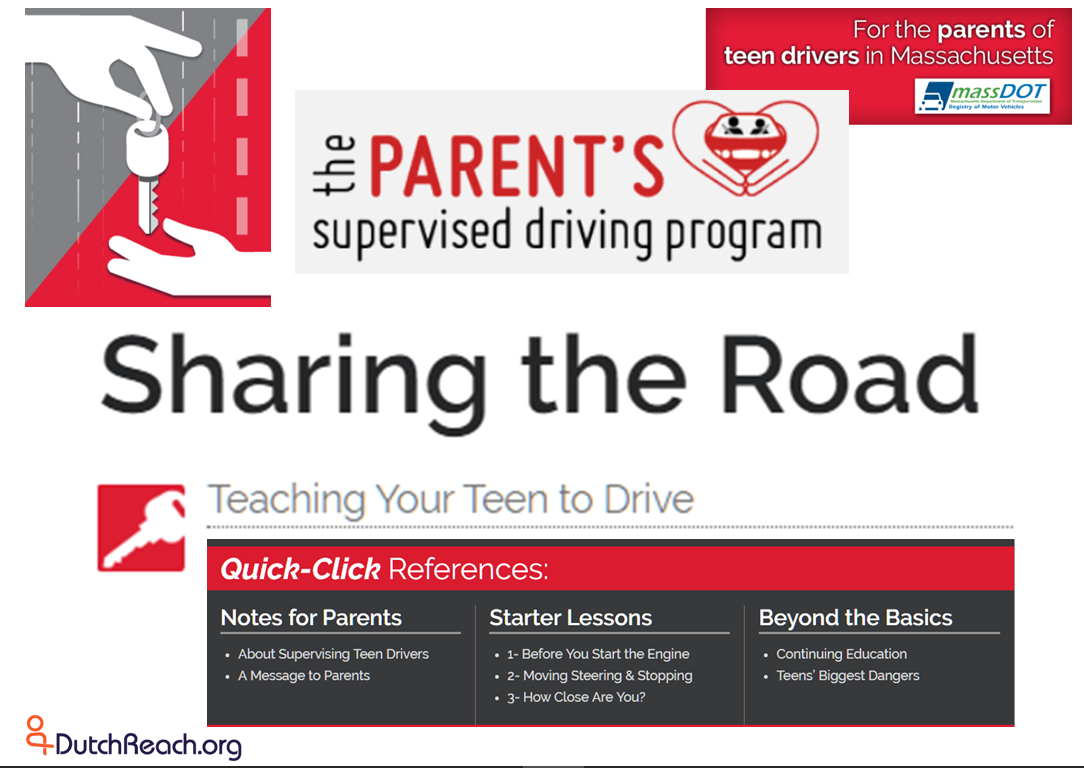
Parent's Supervised Driving Program Manual,, MA RMV. pdf
Parent's Supervised Teen Driver Program, Massachusetts (2017)
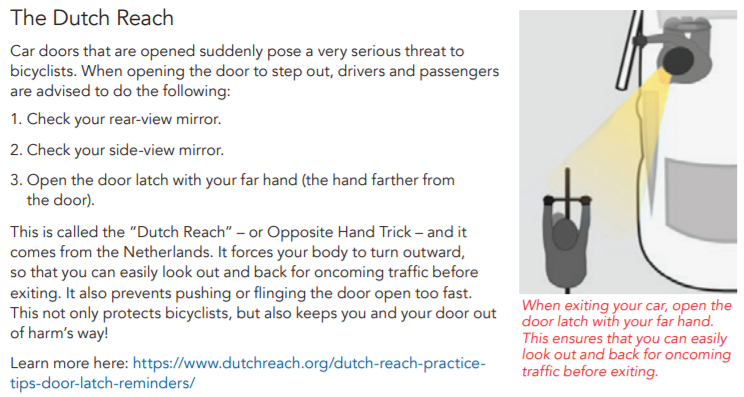
The Dutch Reach, Sharing the road – part two, p. 39. The Parent’s Supervised Driving Program manual, Massachusetts Registry of Motor Vehicles, 2017.
AAA Dutch Reach Advisory in "How to Drive" 15th Ed.
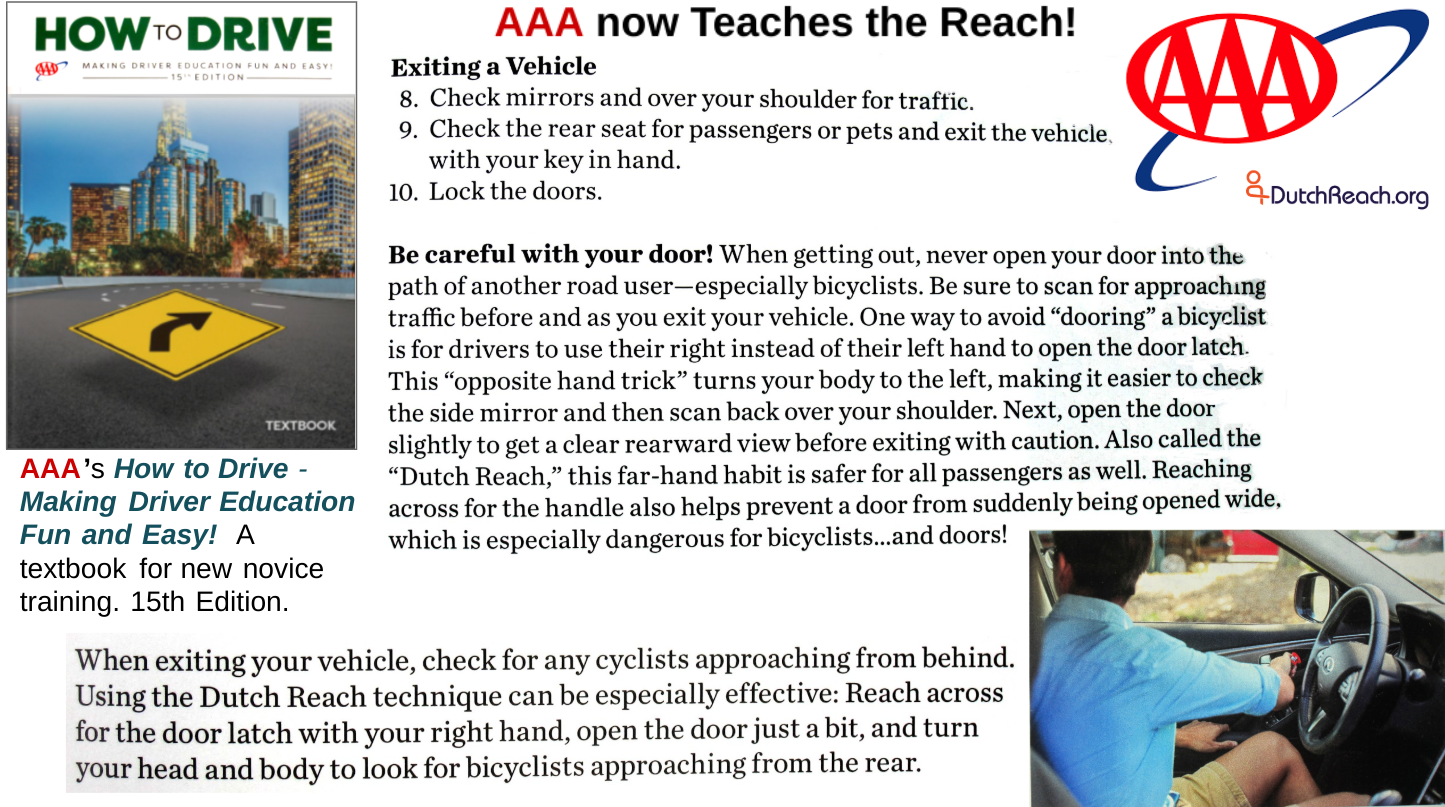
Click image to enlarge; order AAA's How to Drive 15th Edition here [pp. 83-84,231].
City of Burbank, California, USA: Police Dept Infographic
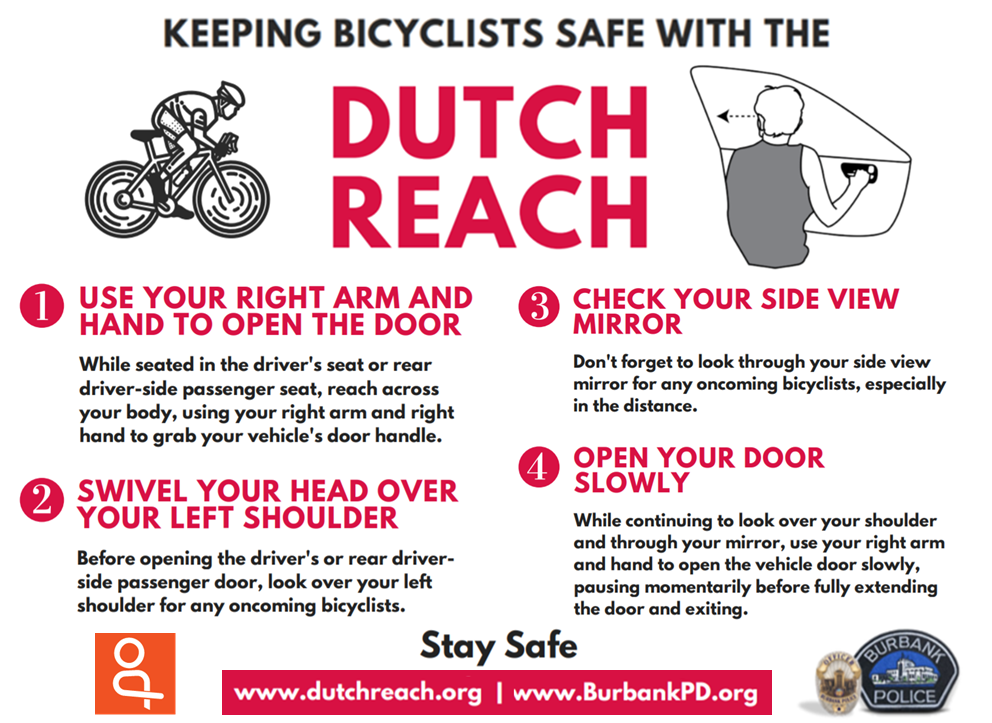
Keeping Cyclists Safe with the Dutch Reach. To prevent dooring cyclists, City of Burbank Police Dept., CA, nfographic (view & download as pdf here). Dutch Reach Project has adapted BPD's design (above). Click image to enlarge.
Washington State - in 7 Languages

Washington State adds 'Dutch Reach' to 2019 Driver Guide - in 7 different language editions. See Chapter 3-p 27 - Parking. Click image to enlarge.
Pennsylvania Dutch!
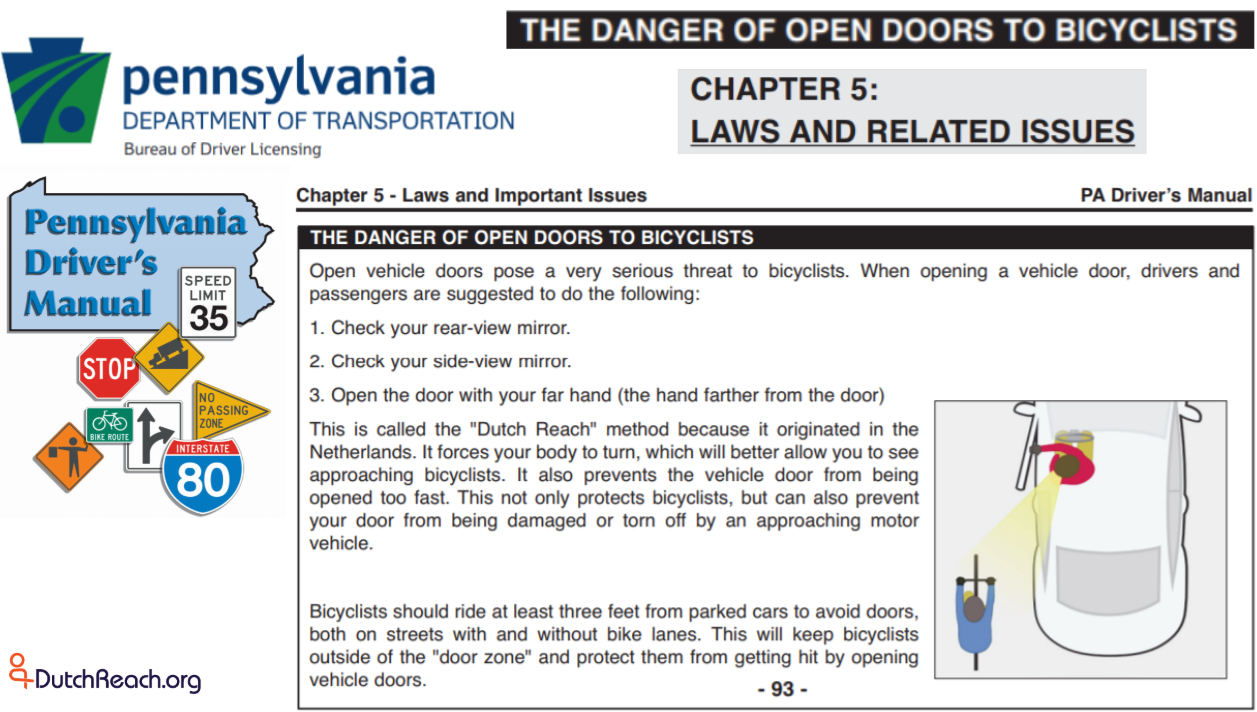
State of Pennsylvania, USA, adds Dutch Reach to 2019 Driver's Handbook, June 10, 2019. PA Manual as pdf, p.93.
State of Illinois, USA Rules of the Road (2018)
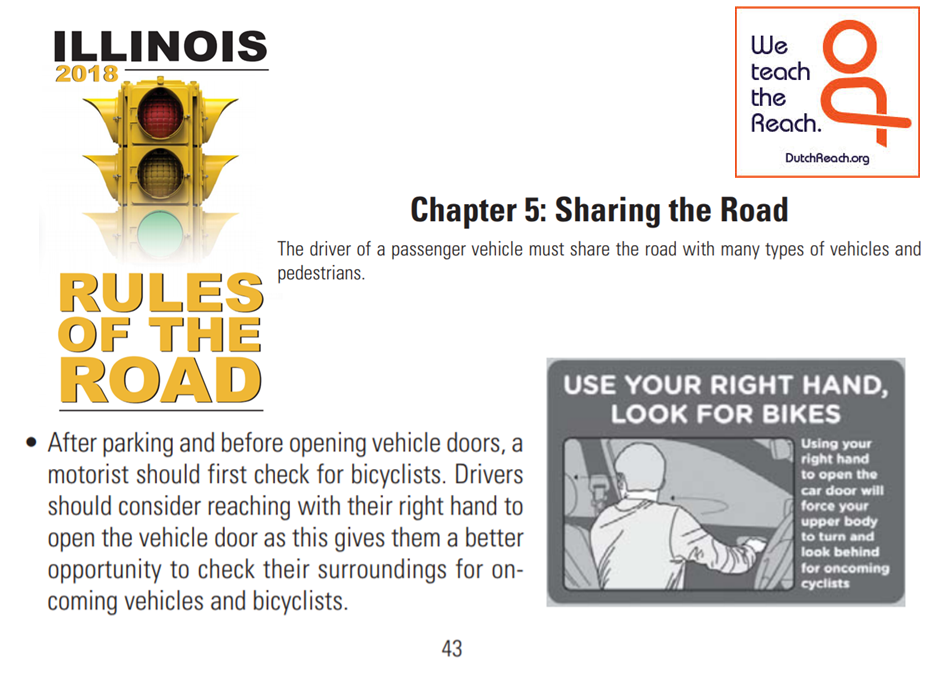
State of Illinois Dept. of Transportation added the far hand 'Reach' method to the 2018 Illinois Rules of the Road. Ride Illiniois & Chicago DOT advocated for Dutch Reach inclusion and created the illustration above now used by IDOT. Illinois is the second US state to adopt the Reach. Click here for Driver's Manual pdf. See p. 43.
Stadt Berlin .de
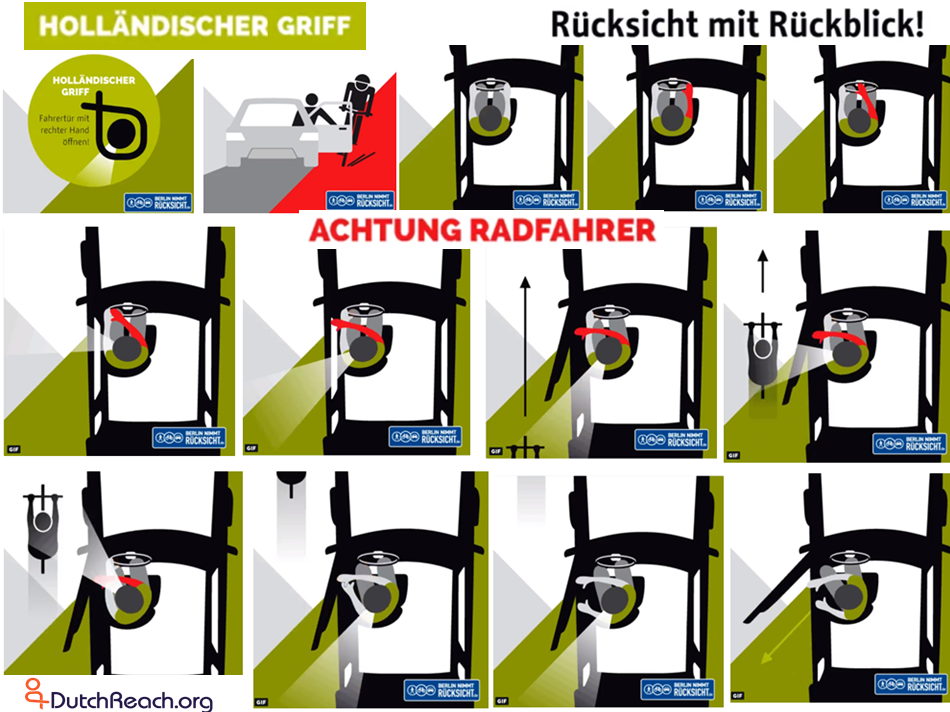
Rücksicht mit Rückblick: den „Holländischen Griff“. Aufspringende Autotüren: Unterschätzte Gefahr für Radfahrende, Berlin.de Pressemitteilung vom 21.03.2018. Mehr: Den Holländischen Griff von Stadt Berlin.
District of Columbia, USA (2017)
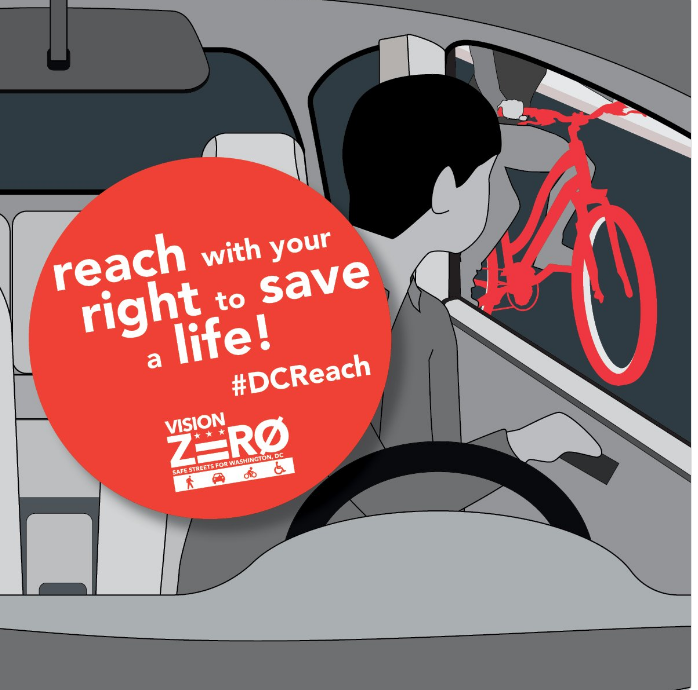
Dutch Reach graphic by District of Columbia DDOT , for #DCReach behavior change initiative, Washington D.C., 2017. Press Release.
New Haven, CT, USA 2013
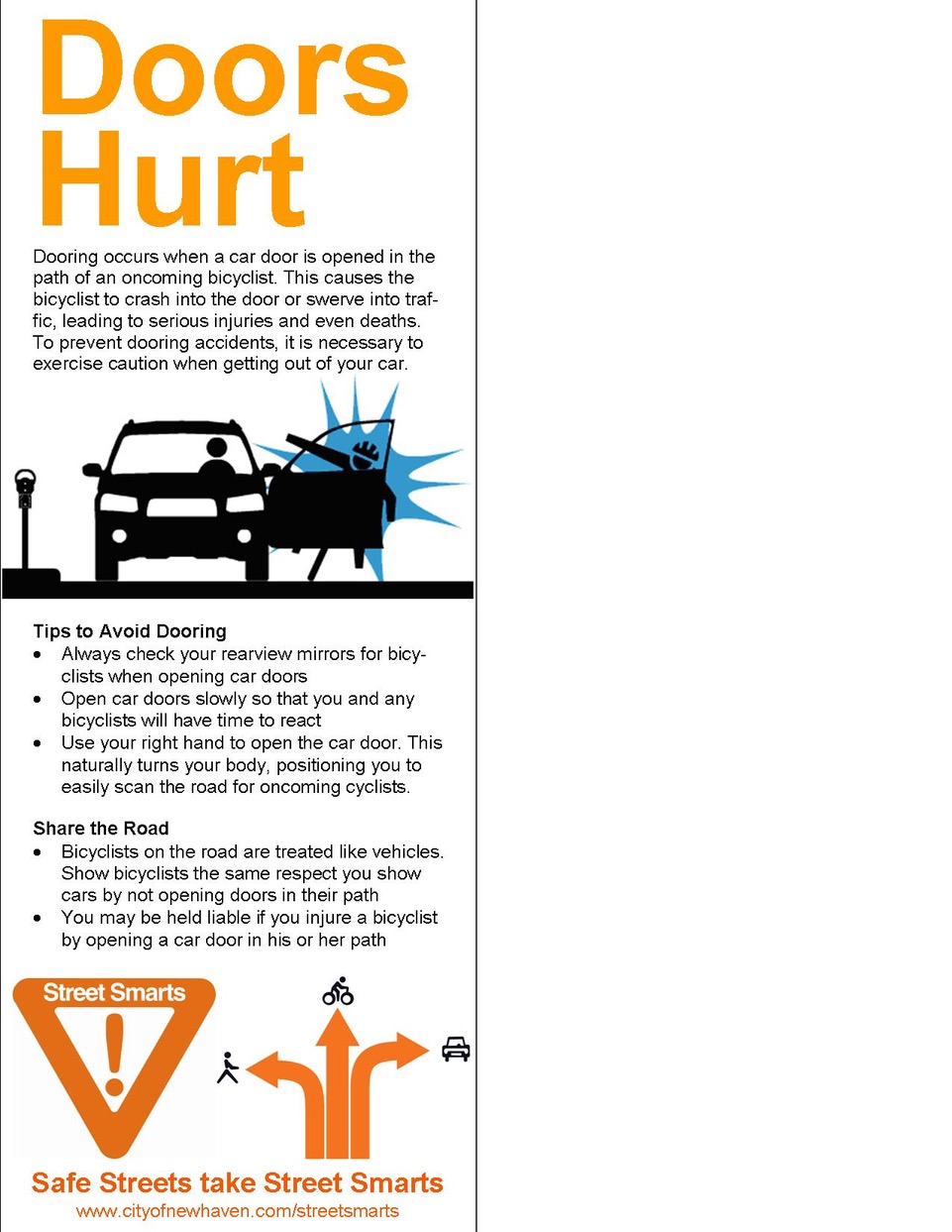
"Doors Hurt" flier, City of New Haven, CT, USA called it the "Amsterdam method," (2013).
UK Will Add to Highway Code ~ 2019
National Safety Council Advanced Defensive Driving Course / Curriculum
NSC's forthcoming revised Advanced Defensive Driving program is said include the “Far Hand Reach” technique for vehicle exiting by drivers & passengers. The DDC 10th edition curricula is to be released January 2019. American Automobile Assn also said to add Reach in 2019. (Cite: NYTs)
Liikenneturva - Finnish Road Safety Council: Hollantilainen Ote
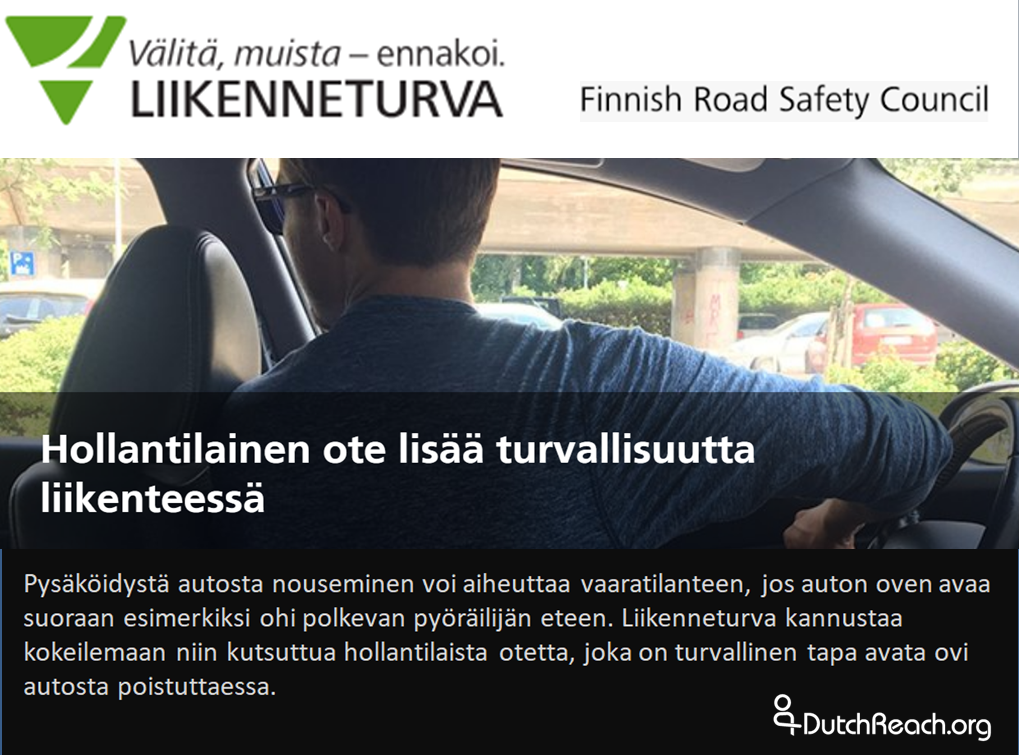
Hollantilainen ote lisää turvallisuutta liikenteessä, Liikenneturva - Finnish Road Safety Council. [A Dutch grip increases safety in traffic.] 25.7.2018
NYS' GTSC Approved Teaching Video
Cycling Guide - Dutch Reach - New York Bicycling Coalition, funded by NHTSA & grant from NYS Governor’s Traffic Safety Comm.
VicRoads, Victoria AUS Transport Agency on Dooring (2012)
Advice for drivers
Bike riders are legitimate road users, and are therefore entitled to use the road just the same as any other road user. Car drivers and bike riders should share the road safely and look out for each other.
Get into the habit of always using your mirrors and doing a head check before openig your car door (one way to do this is to open the car door with your left hand) [Emphasis added - ed.]
Bike riders can travel quickly and may be much closer than you think
When getting into your car, face the oncoming traffic so you can see bike riders (and other road users) travelling towards you. Do not open your car door until they have passed.
Bike riders can ride between parked cars and the lane of traffic so, as a passenger, do not get out of a stationary car when in moving traffic.
South Australia: My License sa gov.au
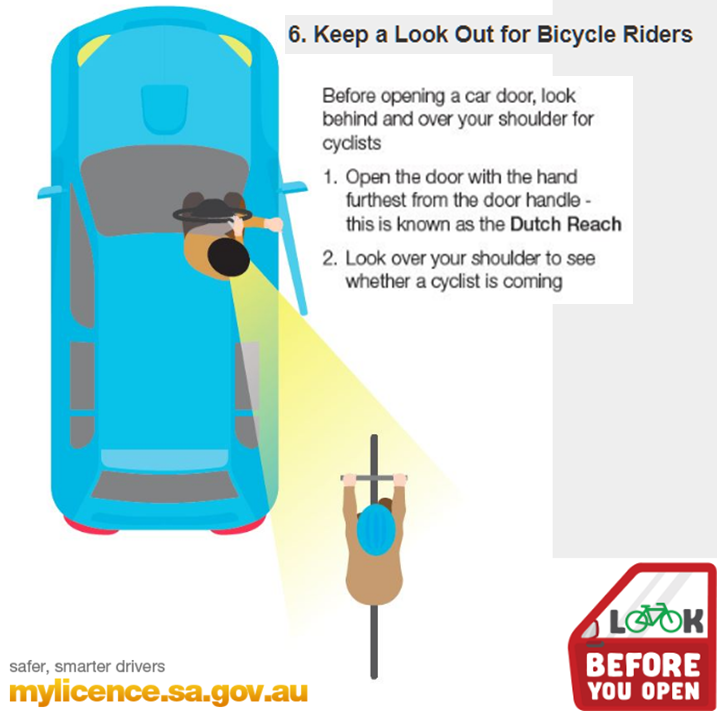
The Driving Companion, Observation (How to use your eyes more effectively) -- advises Dutch Reach method, South Australia "My License" road safety website.
London Cabs to Employ 'Reach'
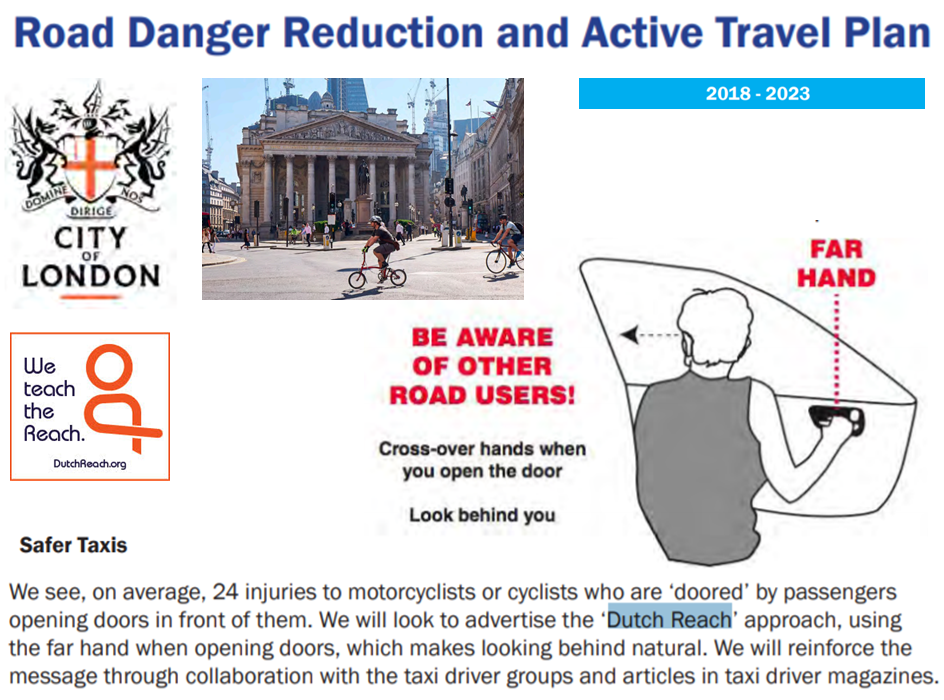
Road Danger Reduction and Active Travel Plan, 2018-2023, [pdf] City of London Corporation, UK, includes Dutch Reach training for hackney carriage drivers & passengers (p. 47) to help achieve London Vision Zero. City will also work with major ride-share companies Addison Lee, Green Tomato & Uber to teach the 'reach'. Related road.cc coverage of Plan here.
Bicycle Network, Australia: Dooring Problem, Solutions - For Drivers
South Australia: My License sa gov.au
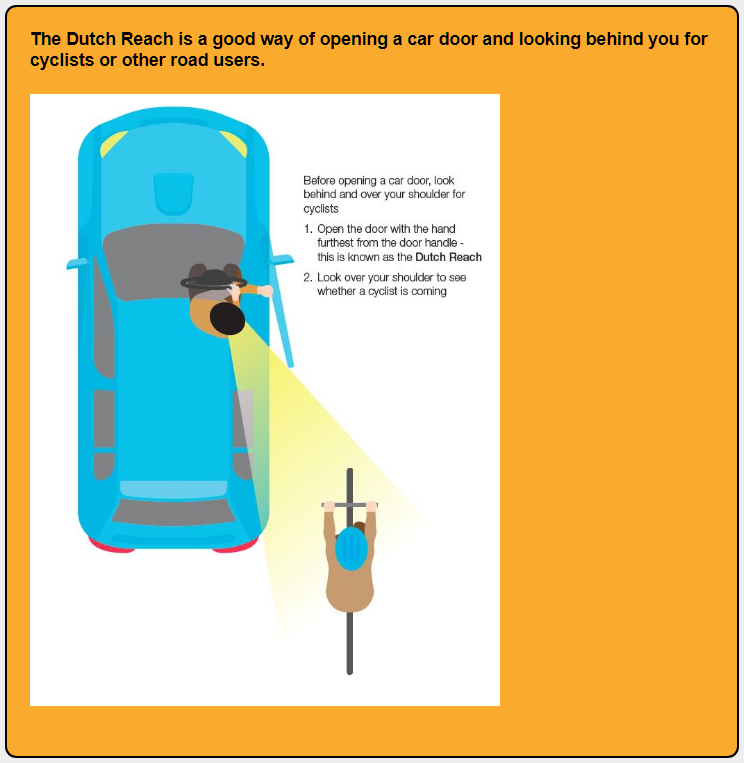
The Driving Companion, Observation (How to use your eyes more effectively) -- advises Dutch Reach method and illustrated by South Australia's "My License" road safety website.
Driver Exiting Lesson Uitstappen uit de auto, Rijleshulp.nl
At left is a 2015 Dutch driving school lesson - Uitstappen uit de auto, Rijleshulp.nl - [Getting Out of the Car, by DrivingHelp NL].
Below is the translated text.
Exiting a car
When exiting a car it’s important to prevent dangerous and hindering situations for yourself and other road users. In this tutorial, you will learn how to exit your car safely. At the end of your driver’s exam you might be asked to exit the car and wait inside the driver’s center to find out whether you passed. This is done to observe how you exit the car and whether you’ll adhere to safety guidelines.
Pay attention, because you could fail your driver’s exam if you don’t!
We will now show you step-by-step how to exit a car safely.
Exiting the car
Step 1
Remove the key from ignition and fold it up, if possible.
Step 2
Look in front of the car, in the inside mirror, the left outside mirror and over your left shoulder!
Step 3
If there’s no oncoming traffic, firmly grab the door handle with your left hand to prevent losing your grip on the door by the wind when opening it. [See 'Vehicle Wind Damage' below].
Step 4
Wait until there is no traffic before you press the button to fold in the outside mirrors.
Step 5
Unlock the door with your right hand!
Step 6
After closing the door, you head into the direction of oncoming traffic to walk to the sidewalk.
Step 7
Once you’ve safely reached the sidewalk, you can lock the car doors with one press on the key(fob).
_______________
Translation most kindly volunteered & provided by Femke Zeilstra (11 February, 2017).
New Zealand Transport Agency
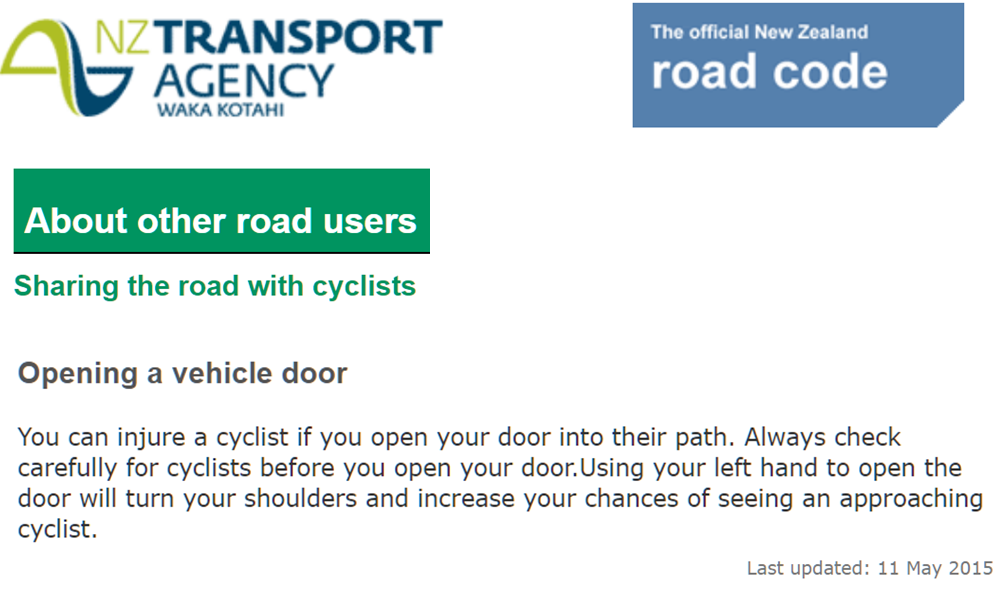
New Zealand Transport Agency, Official Road Code on Opening Vehicle Doors [2016]
Police de la Ville de Montréal
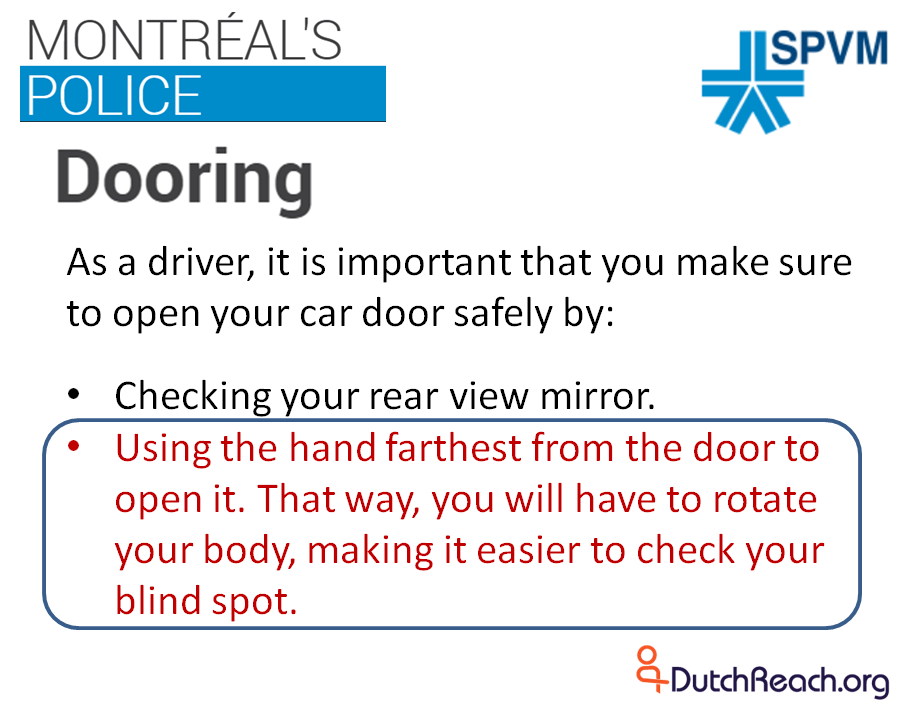 Montréal's Police now advise the far hand / reach across habit to avoid doorings. In 2014 Montréal cyclists launched "Une Porte Une Vie", an anti dooring campaign which advocated the 'reach' method. Click image or Service de Police de la Ville de Montréal - Dooring for webpage.
Montréal's Police now advise the far hand / reach across habit to avoid doorings. In 2014 Montréal cyclists launched "Une Porte Une Vie", an anti dooring campaign which advocated the 'reach' method. Click image or Service de Police de la Ville de Montréal - Dooring for webpage.
Bike Cam Shows Dutch Reach Spare a Boxed-in Cyclist
Note driver's position glimpsed through window at 23 seconds, his far arm with white strip, hand is also visible, reaching door. Driver's door is slightly propped, his body & head turned to peer rearward saw cyclist. He thus delayed further opening. A second vehicle overtakes cyclist as he approached the parked car. Had door been flung or open wider, this ride could have ended tragically.
Excellent Overview Article

For annotated summary, see Dutch Reach under Dooring in Wikipedia or click image.
Dutch Reach: Quod Erat Demonstrandum
QED: "that which was to be demonstrated." @ 23 seconds. (Hungary, 2017). See still at left & explanatory caption.
1st Study: Validating 'Dutch Reach'
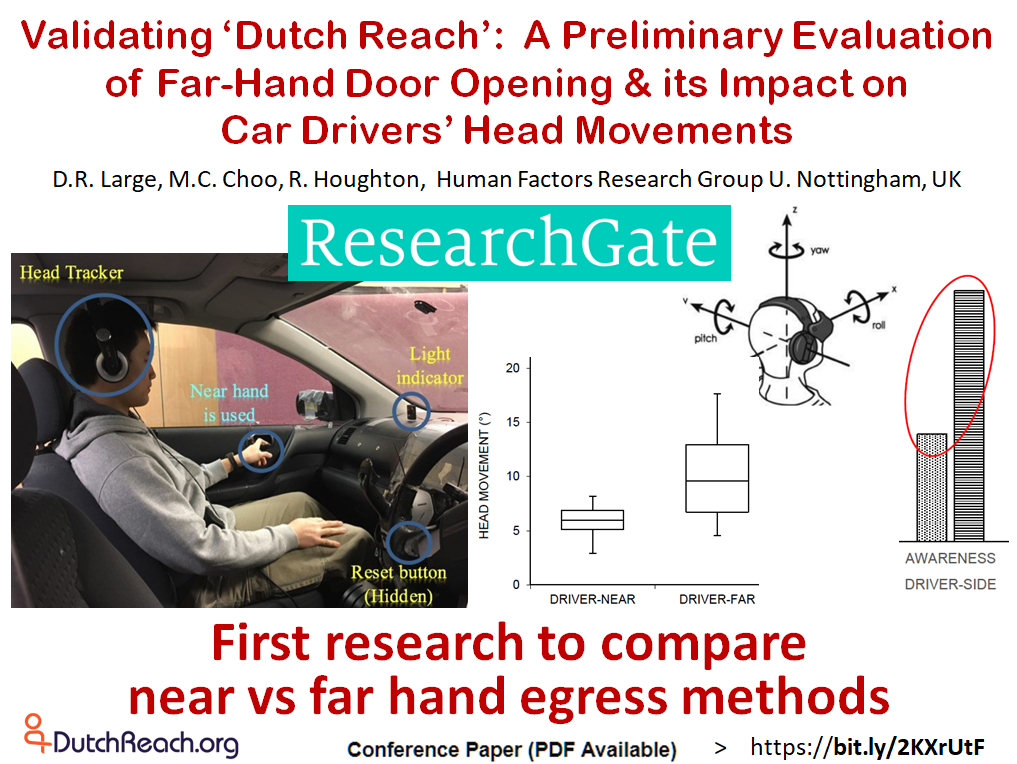
Study finds far hand advantage for Dutch Reach anti dooring method.. See: Validating ‘Dutch Reach’: A Preliminary Evaluation of Far-Hand Door Opening and its Impact on Car Drivers’ Head Movements, Large, DR, et al., Human Factors Research Group, U Nottingham, UK. (PDF). Oct 2018. ICSC 2018 Conference paper. Click image to enlarge.
